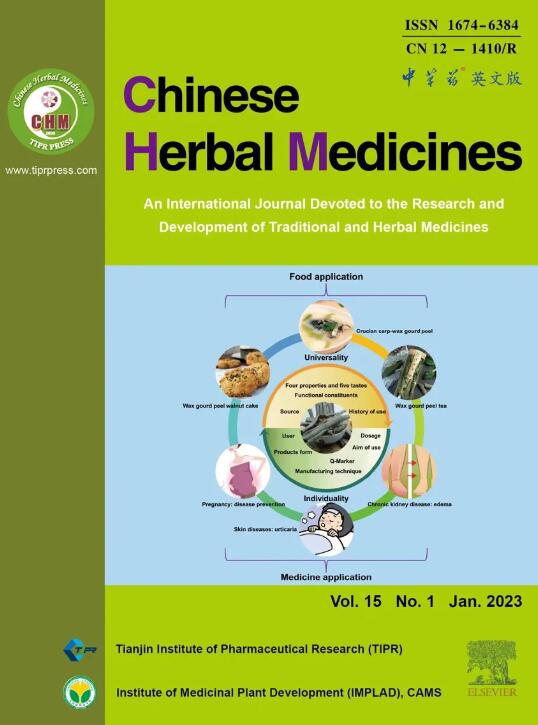Coptis chinensis shows distinct effects on hyperlipidemia and gut microbiota in high-fat diet induced mice with cold or hot syndrome
IF 8.9
4区 医学
Q1 CHEMISTRY, MEDICINAL
引用次数: 0
Abstract
Objective
Coptis chinensis (Huanglian in Chinese, HL) is commonly utilized in clinical settings to counteract dyslipidemia in patients with hot syndrome. Its lipid-reducing efficacy has been consistently demonstrated in high-fat diet (HFD)-induced hyperlipidemic animal models. However, whether HL’s efficacy differs in HFD-fed animals with hot or cold syndromes remains unclear. This study aims to discern the variations in the anti-hyperlipidemic effects of HL in HFD-fed mice with hot or cold syndromes.
Methods
HFD-induced C57BL/6 mice were subjected to cold or hot syndrome via two weeks of ice water (0 °C) and levothyroxine sodium (240 µg/kg) treatment, respectively. Then, an aqueous extract of HL was administered to the mice via oral gavage over the following four-week period. Lipid levels in the serum and liver were gauged to determine the lipid-reducing effects of HL. Furthermore, gut microbiota composition was elucidated using full-length 16S rRNA gene sequencing.
Results
HL notably reduced lipid levels in HFD-induced hyperlipidemic mice. Its efficacy was amplified in hyperlipidemic mice with a hot syndrome but was markedly reduced in those with a cold syndrome. HL treatment led to a decline in alpha-diversity (characterized by ACE, Chao1, Shannon and Simpson index) of the gut microbiota in both sets of mice but affected specific microbial populations based on the syndrome. Specifically, while HL led to a notable increase in Eubacterium, Robinsoniella, and Lachnoclostridium genera, along with the enhancement of Clostridium innocuum and Bacteroides thetaiotaomicron species across all conditions, it syndrome-dependently stimulated Romboutsia ilealis and Parabaceroides_sp_HGS0025 species in mice with hot syndrome.
Conclusion
HL shows stronger lipid-lowering effect on hyperlipidemic mice with hot syndrome, which is in accordance with its traditional usage in clinic. The therapeutic outcomes of HL are intrinsically tied, at least in part, to its modulatory effects on the gut microbiota, offering fresh insights into the foundational principles of traditional Chinese medicine.
黄连对高脂饮食引起的寒、热证小鼠高脂血症和肠道菌群有明显的影响
目的黄连中药是临床治疗热证患者血脂异常的常用中药。其降脂功效已在高脂饮食(HFD)诱导的高脂血症动物模型中得到一致证明。然而,hfd喂养的热证或寒证动物是否有不同的疗效尚不清楚。本研究旨在探讨HL在热证和寒证小鼠中抗高脂血症作用的变化。方法将shfd诱导的C57BL/6小鼠分别以冰水(0°C)和左旋甲状腺素钠(240µg/kg)处理2周,形成冷证和热证。然后,在接下来的四周时间里,通过灌胃给小鼠HL的水提取物。测定血清和肝脏中的脂质水平,以确定HL的降脂作用。此外,利用16S rRNA基因全长测序技术对肠道菌群组成进行了分析。结果shl可显著降低hfd诱导的高脂血症小鼠的脂质水平。它的功效在热证高脂血症小鼠中被放大,但在寒证小鼠中被显著降低。HL治疗导致两组小鼠肠道菌群α -多样性(以ACE、Chao1、Shannon和Simpson指数为特征)下降,但基于综合征的特定微生物种群受到影响。具体而言,在所有条件下,HL均能显著增加真菌菌属、Robinsoniella属和Lachnoclostridium属,以及无毒梭菌属(Clostridium innocuum)和拟杆菌属(Bacteroides thetaiotaomicron)属的数量,但在热证小鼠中,HL可刺激回肠Romboutsia和Parabaceroides_sp_HGS0025种。结论黄芪对高脂血症热证小鼠有较强的降脂作用,符合其临床传统用法。HL的治疗结果本质上与它对肠道微生物群的调节作用有关,至少在一定程度上,这为传统中医的基本原理提供了新的见解。
本文章由计算机程序翻译,如有差异,请以英文原文为准。
求助全文
约1分钟内获得全文
求助全文
来源期刊

Chinese Herbal Medicines
CHEMISTRY, MEDICINAL-
CiteScore
4.40
自引率
5.30%
发文量
629
审稿时长
10 weeks
期刊介绍:
Chinese Herbal Medicines is intended to disseminate the latest developments and research progress in traditional and herbal medical sciences to researchers, practitioners, academics and administrators worldwide in the field of traditional and herbal medicines. The journal's international coverage ensures that research and progress from all regions of the world are widely included.
CHM is a core journal of Chinese science and technology. The journal entered into the ESCI database in 2017, and then was included in PMC, Scopus and other important international search systems. In 2019, CHM was successfully selected for the “China Science and Technology Journal Excellence Action Plan” project, which has markedly improved its international influence and industry popularity. CHM obtained the first impact factor of 3.8 in Journal Citation Reports (JCR) in 2023.
 求助内容:
求助内容: 应助结果提醒方式:
应助结果提醒方式:


